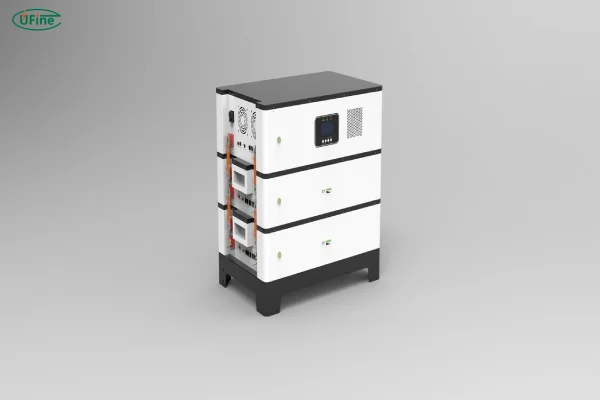Part 1. What is a stacked battery?
In the world of energy storage, innovations continue to change the way we power our devices. One such innovation is the stacked battery, a type of battery design that maximizes efficiency and power density. But what exactly is a stacked battery, and why are they gaining so much attention?
A stacked battery refers to a configuration where multiple individual cells are stacked on top of one another, often in a compact arrangement. This design increases the total energy capacity of the battery while maintaining a smaller physical footprint. Stacked batteries are commonly used in various modern technologies, including lithium-ion stacked batteries, which are widely favored for their high energy density and long lifespan.
In simple terms, stacked batteries are like layers of energy storage, each layer contributing to the overall power and efficiency of the system.
Part 2. Structure and components
A stacked battery is built up of several key components that work together to store and release energy efficiently. Here’s a breakdown of its basic structure:
-
Battery Cells: At the core of the stacked battery, you’ll find individual cells that are responsible for storing energy. Each cell typically consists of a positive terminal (cathode), a negative terminal (anode), and an electrolyte that allows ions to flow between them. In a lithium-ion stacked battery, the cells are often made of lithium metal oxide for the cathode, graphite for the anode, and lithium salts as the electrolyte.
-
Battery Separator: A separator is placed between the layers of cells to prevent short circuits. It allows ions to pass through but keeps the positive and negative terminals apart.
-
Conductive Connectors: These connectors link the individual cells, allowing the battery to transfer energy between them. They play a crucial role in maintaining efficient electrical conductivity and ensuring that the stacked battery works as a single unit.
-
Thermal Management System: Stacked batteries, especially lithium-ion variants, generate heat during charging and discharging. A thermal management system, including heat sinks or liquid cooling, helps dissipate heat and maintain an optimal operating temperature.
-
Protective Circuitry: To prevent overcharging, overheating, or deep discharging, stacked batteries are often equipped with battery management systems (BMS). These systems monitor the health of the battery and ensure safe operation.
This combination of components gives the stacked battery its high energy density and reliability, making it suitable for a wide range of applications.
Part 3. Working principle
The technology behind stacked batteries, especially lithium-ion stacked batteries, relies on a basic principle of electrochemical reactions. The working principle is as follows:
-
Energy Storage: During charging, lithium ions move from the cathode (positive terminal) to the anode (negative terminal), where they are stored. The flow of electrons through the external circuit provides the electric current needed to charge devices or vehicles.
-
Energy Release: When the battery discharges, the stored lithium ions move back from the anode to the cathode, releasing energy in the form of electrical current. This process powers your device or vehicle.
The advantage of stacking cells is that it increases the overall voltage and capacity without increasing the battery’s physical size significantly. By layering the cells, the battery can store more energy, making it efficient for use in devices that require a high energy output but have limited space.
Part 4. Types of stacked batteries
While the lithium-ion stacked battery is the most well-known type, stacked batteries come in various forms, each suited to different applications. Here are some of the main types:
-
Lithium-Ion Stacked Batteries: These are the most common and widely used due to their high energy density, long cycle life, and lightweight design. They are used in everything from smartphones and laptops to electric vehicles and renewable energy systems.
-
Nickel-Metal Hydride (NiMH) Stacked Batteries: Although less popular than lithium-ion batteries, NiMH batteries are still used in certain applications, such as hybrid vehicles and portable devices. They offer a lower energy density but are safer and more environmentally friendly.
-
Lead-Acid Stacked Batteries: These are older technology but still used in applications like backup power systems and automotive starting batteries. They are larger and heavier than lithium-ion batteries but are more cost-effective.
-
Solid-State Stacked Batteries: An emerging technology, solid-state batteries use solid electrolytes instead of liquid ones. They promise to offer higher energy density, faster charging times, and improved safety, but they are still in the experimental stage.
Each type has its own advantages and disadvantages, with lithium-ion stacked batteries being the go-to for most high-performance applications due to their balance of power, efficiency, and lifespan.
Part 5. Advantages of stacked batteries
Stacked batteries, especially lithium-ion stacked batteries, come with a range of benefits that make them ideal for many modern applications:
-
High Energy Density: By stacking multiple cells, these batteries can store more energy in a smaller space, making them ideal for devices and vehicles where space is limited.
-
Longer Lifespan: Lithium-ion stacked batteries tend to have longer cycle lives compared to traditional batteries, meaning they can be charged and discharged more times without significant loss of capacity.
-
Fast Charging: Stacked batteries, particularly lithium-ion, can be designed for fast charging, which reduces the downtime for devices and electric vehicles.
-
Lightweight: Compared to older battery types like lead-acid, stacked lithium-ion batteries are much lighter, which is crucial for applications in mobile devices and electric vehicles.
-
Scalability: Stacked batteries can be customized to meet the energy requirements of various applications, whether you need a small power source for a wearable device or a large one for an electric car.
Part 6. Disadvantages of stacked batteries
While stacked batteries offer many advantages, they also come with a few drawbacks:
-
Cost: Lithium-ion stacked batteries, in particular, can be expensive to produce, especially for high-capacity models.
-
Safety Concerns: Although generally safe, lithium-ion batteries can pose risks if damaged, overcharged, or improperly handled. Battery management systems and thermal management are essential to mitigate these risks.
-
Limited Temperature Range: Stacked batteries are sensitive to extreme temperatures. Overheating can cause thermal runaway in lithium-ion batteries, while cold temperatures can reduce their performance.
-
Complexity: The design and assembly of stacked batteries can be more complex than traditional battery types. Proper thermal management and battery management systems are essential for safe and efficient operation.
Part 7. Differences between stacked batteries and battery packs
While both stacked batteries and battery packs store energy, they differ in their structure and design. Here’s a quick comparison:
- Stacked Battery: Typically involves multiple cells stacked on top of each other in a compact form. The cells are connected in series or parallel to increase voltage or capacity.
- Battery Pack: Refers to a collection of individual cells that may or may not be stacked. A battery pack is often used to describe a more complex system that integrates several cells into a larger unit, along with electronics for managing power.
In essence, all stacked batteries are part of a battery pack, but not all battery packs are made up of stacked cells.
Part 8. Applications
Stacked batteries, particularly lithium-ion stacked batteries, have found their way into a wide range of industries and applications:
-
Electric Vehicles (EVs): The most common use for lithium-ion stacked batteries today is in electric vehicles. Their high energy density makes them ideal for powering cars, trucks, and even electric bikes.
-
Consumer Electronics: Laptops, smartphones, and tablets all rely on stacked batteries for efficient energy storage and long-lasting performance.
-
Renewable Energy: Stacked batteries are also used in solar and wind energy systems, providing storage for excess energy generated during peak production times.
-
Uninterruptible Power Supplies (UPS): Stacked batteries are used in backup power systems, providing emergency power when the main supply fails.
Part 9. Trends in stacked batteries
As technology evolves, so does the demand for more efficient and powerful batteries. Here are some key trends in the development of stacked batteries:
-
Solid-State Batteries: The next generation of stacked batteries is moving toward solid-state technology, which promises better energy efficiency, faster charging, and higher safety standards.
-
Wireless Charging: As wireless charging technology advances, there is a growing focus on designing stacked batteries that can charge wirelessly, making charging more convenient.
-
Sustainability: As the world shifts towards greener solutions, there is a growing emphasis on recycling and using sustainable materials in the production of stacked batteries.
-
Higher Energy Density: Researchers are continually working to improve the energy density of stacked batteries, which will allow for even smaller and more powerful energy storage systems in the future.
10. Conclusion
Stacked batteries, especially lithium-ion stacked batteries, are at the forefront of modern energy storage technology. Their compact design, efficiency, and adaptability make them ideal for a wide range of applications, from electric vehicles to consumer electronics. As technology continues to improve, stacked batteries will play an even bigger role in shaping the future of energy storage. Whether you’re a tech enthusiast or simply curious about how your devices work, understanding stacked batteries is essential in today’s energy-driven world.
Related Tags:
More Articles

How to Choose the Best Floor Scrubber Battery for Commercial Cleaning?
Selecting the ideal floor scrubber battery ensures a long runtime, rapid charging, and minimal maintenance for efficient commercial cleaning operations.
Battery for Blower vs Battery for Leaf Vacuum: Which One Should You Choose?
Battery for blower vs leaf vacuum—learn the key differences in power, fit, and runtime to choose the right battery for your outdoor tool needs.
How to Choose the Right Battery for Blower?
Choosing the right blower battery? Consider voltage, capacity, chemistry & usage. This guide helps match the best battery for peak performance.
How to Choose the Best Insulated Battery Box for Lithium Batteries?
Choosing the Best Insulated Battery Box for Lithium Batteries? Discover key factors such as size, material, and safety for optimal protection and performance.
7 Critical Elements on a Lithium Battery Shipping Label
What must be on a lithium battery shipping label? Learn 7 key elements to ensure safety, legal compliance, and correct handling across all transport modes.





